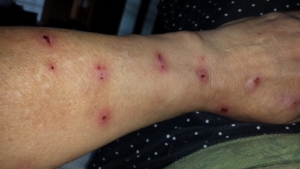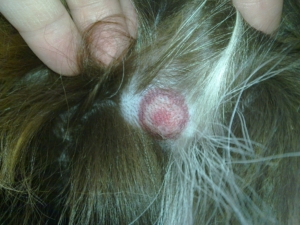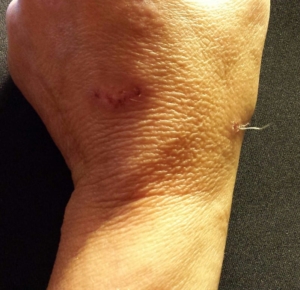Understanding the Connection Between Morgellons and Lyme
Morgellons disease is a complex skin disorder characterized by slow-healing skin sores with unusual fibers sticking out from the skin or embedded under unbroken skin.
Many medical professionals call Morgellons disease a delusional parasitosis because they believe patients scratch and itch their skin until they bleed. They assume accompanying fibers are textile filaments stuck to the skin.
In other words, some medical professionals think an imaginary parasitic infection causes their patients’ symptoms.
However, extensive research concludes that infections spread by ticks can contribute to Morgellons disease—which may be a manifestation of Lyme disease. If you or someone you love has been suffering from unresolved Morgellons symptoms, you can probably blame an underlying bacterial infection.
In partnership with medical researchers, the Charles E. Holman Morgellons Disease Foundation funds groundbreaking studies that increase our understanding of this debilitating disease. Through our research and grassroots efforts, we hope to provide hope and healing to patients as we strive to understand the root causes of their symptoms.
As many medical professionals doubt that an underlying bacterial infection causes Morgellons, we’ll guide you through the studies that provide the most conclusive results.
What is Morgellons disease?

Morgellons Disease Lesions on Wrist
Patients with Morgellons disease experience spontaneous, slow-healing and painful ulcerating skin lesions across their head, face, trunk, or limbs. These lesions can be quite large and leave disfiguring scars.
Patients suffering from Morgellons also experience strange fibers or filaments that sprout from their skin and grow deep between skin layers. Morgellons fibers are made out of keratin and collagen proteins stemming from skin cells that an infectious bacteria invaded.
Nearly all Morgellons patients studied test positive for Borrelia burgdorferi infections. Borrelia burgdorferi is a group of spirochetal bacteria transmitted through black-legged tick bites and quickly spread from the site of the bite through the body if left untreated.
As the bacteria spreads throughout the body, it takes up residence in the tissues, which causes joint, heart, and nervous system problems such as:
- Fatigue
- Arthritis
- Meningitis
- Neuropathies
- Muscular pain
- Cardiac disease
- Ulcerating lesions
- Cognitive dysfunction
- Unusual skin fiber growth
- Erythema migrans (bulls-eye) rash
Many of these symptoms mirror Lyme disease. The parallel makes sense since the same group of bacteria is responsible for both conditions.
What is Lyme Disease?

Tick “questing” for the next host
Lyme borreliosis, otherwise known as Lyme disease, is another tick-borne illness caused by Borrelia burgdorferi, a spirochetal bacteria. Borrelia burgdorferi spirochetes live in ticks found in two main regions in the United States: the northeast and mid-Atlantic region and the north-central region. However, both infected areas have grown considerably over the last two decades to reach southern Canada.
A group of children living in Lyme, Connecticut, became the first documented cases of Lyme arthritis in 1976.
Since then, medical researchers have found that Lyme disease is a complicated illness encompassing a broad range of symptoms beyond arthritis. These symptoms attack many systems of the body, including the following:
- Skin
- Joints
- Heart
- The nervous system
The CDC estimates that 300,000 people per year fall victim to Lyme disease.
Lyme borreliosis spreads to humans through tick bites from infected black-legged ticks. Borrelia burgdorferi spirochetes live inside the ticks, travel through the tick’s saliva, and enter the tick’s bite site to infect human hosts.
Once inside the skin, the spirochetes quickly spread through the body. The spirochetes do this using adaptations that allow them to outmaneuver the host immune system while passing through tissues too dense for the defense.

An example of an Erythema Rash
A small portion of Lyme patients experience an Erythema migrans (EM) or a bulls-eye rash—the tell-tale sign of a Borrelia burgdorferi infection. The bulls-eye rash is considered a type of lesion. Patients may exhibit the rash for anywhere from three days to a month after being bit by an infected tick. The delay makes it harder to diagnose the cause.
The bulls-eye nickname comes from the dark red patch of skin in the middle of an irritated red ring. These bulls-eye rashes grow as the illness progresses. While bulls-eye rashes are a tell-tale sign of Lyme borreliosis infection, these rashes are often misdiagnosed or dismissed due to irregular shapes or presentations that don’t follow the perceived norm.
If left untreated, the bacterial infection will disseminate, potentially spreading secondary rashes to other areas of the body.
Usually, an antibiotic regimen will resolve Borrelia infections and their symptoms.
While many patients with both Lyme and Morgellons diseases experience bulls-eye rashes, most patients with tick-spread Borrelia infections do not, making a positive diagnosis difficult.
When bulls-eyerashes don’t manifest with symptoms consistent with Lyme disease, a clinician may conduct blood tests for Lyme. Unfortunately, limitations of the testing mean that many patients receive false negative results, hampering their ability to get treatment and allowing their illness to intensify relatively unchecked.
Lyme and Morgellons

Morgellons Disease Fiber Extrusion on wrist
In this study, researchers identified 25 Morgellons patients based on fiber growth and ulcerating lesions. They collected tissue and body-fluid samples to test rigorously at three independent laboratories. While only two-thirds of the patients met the criteria for CDC Lyme Surveillance, everyone tested positive for a Borrelia burgdorferi infection despite taking antibiotics to treat their symptoms.
Researchers concluded that Morgellons disease is a manifestation of Lyme borreliosis, the infection responsible for Lyme disease.
Though researchers don’t yet understand why, only a small subgroup of Lyme disease patients—mostly middle-aged caucasian women—develop Morgellons symptoms. These nasty symptoms include fiber growth, ulcerating lesions, debilitating fatigue, and cognitive decline.
Patients in this subgroup have trouble conquering their spirochetal infections independently and sometimes even after help from antibiotics. Without successful treatment, symptoms and the underlying infection may persist for months or even years without relief.
If you or a loved one are suffering from Morgellons disease and don’t know where to turn, you can find doctors who understand your condition through our website.
We still have much to learn about Morgellons disease.
Please consider donating to our foundation today. Every dollar donated goes to help fund research that will provide relief to suffering patients, improve diagnosis, and educate doctors and patients on better paths to healing.

